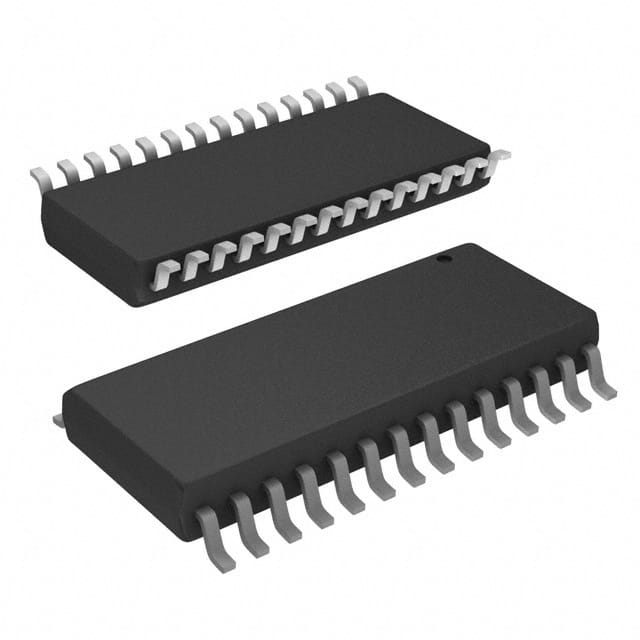Szczegóły produktu można znaleźć w specyfikacjach.

ADS801U
Product Overview
Category: Integrated Circuit (IC)
Use: The ADS801U is a high-performance analog-to-digital converter (ADC) designed for various applications in the field of electronics. It converts analog signals into digital data, enabling accurate and reliable measurements.
Characteristics: - High resolution: The ADS801U offers a resolution of up to 16 bits, ensuring precise conversion of analog signals. - Fast sampling rate: With a maximum sampling rate of 1 Mega-Samples per second (MSPS), it can capture rapid changes in analog signals. - Low power consumption: The ADC operates with low power requirements, making it suitable for battery-powered devices. - Wide input voltage range: It supports a wide range of input voltages, allowing flexibility in signal acquisition. - Small package size: The ADS801U comes in a compact package, making it easy to integrate into various electronic systems.
Package and Quantity: The ADS801U is available in a small outline integrated circuit (SOIC) package. Each package contains one unit of the ADC.
Specifications
- Resolution: Up to 16 bits
- Sampling Rate: Up to 1 MSPS
- Input Voltage Range: ±10V
- Power Supply: +5V
- Operating Temperature Range: -40°C to +85°C
- Package Type: SOIC
Pin Configuration
The ADS801U has a total of 20 pins, each serving a specific function. The pin configuration is as follows:
- VREF-
- VREF+
- AGND
- AVDD
- DVDD
- CLK
- CS
- DIN
- DOUT
- DGND
- REFOUT
- REFBUF
- AIN0
- AIN1
- AIN2
- AIN3
- AIN4
- AIN5
- AIN6
- AIN7
Functional Features
- High-resolution conversion: The ADS801U provides accurate and precise analog-to-digital conversion, ensuring reliable data acquisition.
- Flexible input voltage range: It supports a wide range of input voltages, allowing compatibility with various signal sources.
- Low power consumption: The ADC operates efficiently with low power requirements, making it suitable for power-sensitive applications.
- Serial interface: The ADS801U features a serial interface for easy integration with microcontrollers or other digital systems.
Advantages and Disadvantages
Advantages: - High resolution enables accurate measurement. - Fast sampling rate captures rapid changes in signals. - Low power consumption extends battery life. - Wide input voltage range allows flexibility in signal acquisition. - Compact package size facilitates integration into electronic systems.
Disadvantages: - Limited number of input channels (8 channels). - Requires external reference voltage for optimal performance.
Working Principles
The ADS801U utilizes successive approximation register (SAR) architecture to convert analog signals into digital data. It samples the input voltage, compares it to a reference voltage, and generates a binary code representing the analog value. This process is repeated for each sample, resulting in a stream of digital data.
Application Field Plans
The ADS801U finds applications in various fields, including: 1. Industrial automation: Used for precise measurement and control in manufacturing processes. 2. Medical devices: Enables accurate data acquisition in medical monitoring equipment. 3. Test and measurement instruments: Provides high-resolution measurements for scientific and engineering purposes. 4. Audio equipment: Used in audio interfaces and recording devices for capturing analog audio signals.
Alternative Models
For users seeking alternative options, the following models offer similar functionality to the ADS801U: 1. ADS802U: A higher-resolution ADC with 18-bit conversion capability. 2. ADS800U: A lower-resolution ADC with 12-bit conversion capability. 3. ADS804U: A quad-channel ADC, allowing simultaneous conversion of multiple input signals.
These alternative models provide users with a range of options based on their specific requirements.
Word count: 495 words
Wymień 10 typowych pytań i odpowiedzi związanych z zastosowaniem ADS801U w rozwiązaniach technicznych
Sure! Here are 10 common questions and answers related to the application of ADS801U in technical solutions:
Q: What is the ADS801U? A: The ADS801U is a high-performance analog-to-digital converter (ADC) designed for various technical applications.
Q: What is the resolution of the ADS801U? A: The ADS801U has a resolution of 12 bits, allowing it to convert analog signals into digital values with high precision.
Q: What is the sampling rate of the ADS801U? A: The ADS801U has a maximum sampling rate of 1 megasample per second (MSPS), enabling fast and accurate data acquisition.
Q: Can the ADS801U be used in low-power applications? A: Yes, the ADS801U features a low-power mode that reduces its power consumption, making it suitable for battery-powered devices.
Q: What is the input voltage range of the ADS801U? A: The ADS801U has a differential input voltage range of ±Vref, where Vref can be set between 0.5V and 2.048V.
Q: Does the ADS801U support multiple input channels? A: No, the ADS801U is a single-channel ADC, meaning it can only convert one analog signal at a time.
Q: Can the ADS801U interface with microcontrollers or processors? A: Yes, the ADS801U has a serial peripheral interface (SPI) that allows it to communicate with microcontrollers or processors.
Q: Is the ADS801U compatible with both 3.3V and 5V systems? A: Yes, the ADS801U supports both 3.3V and 5V supply voltages, making it versatile for different system requirements.
Q: What are some typical applications of the ADS801U? A: The ADS801U is commonly used in data acquisition systems, industrial automation, medical devices, instrumentation, and more.
Q: Does the ADS801U provide any built-in features for signal conditioning? A: Yes, the ADS801U includes a programmable gain amplifier (PGA) and a digital offset calibration feature to enhance signal quality.
Please note that these answers are general and may vary depending on the specific implementation and requirements of your technical solution.

